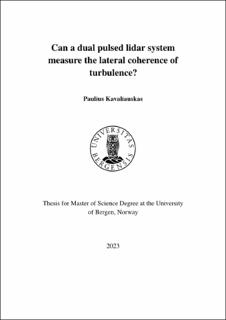Can a dual pulsed lidar system measure the lateral coherence of turbulence?
| dc.contributor.author | Kavaliauskas, Paulius | |
| dc.date.accessioned | 2023-08-09T23:41:42Z | |
| dc.date.available | 2023-08-09T23:41:42Z | |
| dc.date.issued | 2023-08-10 | |
| dc.date.submitted | 2023-08-09T22:00:22Z | |
| dc.identifier.uri | https://hdl.handle.net/11250/3083245 | |
| dc.description.abstract | Characterizing the coherence of turbulence in the marine boundary layer faces a significant challenge due to the limited availability of offshore measurements within the relevant altitude ranges, particularly up to 250 m. The coherence of turbulence describes the spatial correlation of wind velocity fluctuations, which is a key parameter for determining environmental loading on wind turbines. The turbulent wind loading represents one of the main uncertainties faced by the offshore wind engineering sector. Uncertainties arising from turbulent wind loading represent major challenges in the offshore wind engineering sector. Advancements in remote sensing technology, such as Doppler wind lidars, have opened new possibilities for studying wind turbulence at heights relevant to the increasing size of wind turbine rotors. This master’s thesis presents an analysis of 15 days of wind records collected by two pulsed wind lidars and two sonic anemometers during the COTUR project at Obrestad lighthouse, located on the southwestern coast of Norway. The site is expected to predominantly represent offshore conditions. The primary objective of this study is to assess the capability of pulsed Doppler wind lidar instruments in capturing the lateral co-coherence of turbulence along the wind component. Wind records obtained by the sonic anemometers mounted on 11 m high masts are used as reference data. The analysis focuses on both single and two-point statistics of wind turbulence, with particular emphasis on studying the co-coherence of turbulence. The results revealed that wind sectors aligned with northerly or southerly wind directions are suitable for comparison studies. In these wind directions, a good agreement is found between the two different instruments. Comparing co-coherence estimates obtained from pulse lidar and sonic anemometer showed negligible differences, indicating that spatial averaging did not significantly affect the estimation of co-coherence. By assessing the ability of pulsed Doppler wind lidar instruments to capture turbulence co-coherence, this study contributes to the applicability of lidar technology for characterizing turbulence and its potential for improving assessments of environmental loading on offshore wind turbines | |
| dc.language.iso | eng | |
| dc.publisher | The University of Bergen | |
| dc.rights | Copyright the Author. All rights reserved | |
| dc.subject | #Coherence#Co-coherence#Scanning Lidar#Long-range sanning Lidar#Pulse Lidar#WindScanners# 3D Sonic anemomer# Tubulence# Coherence of turbulence#Validation#Wind power#Wind engineering#Offshore wind#Marine Boundary#Layer#atmospheric boundary #layer#surface layer#Power Specral Density#Lateral Coherence#Along-wind velocity#Along-beam velocity | |
| dc.title | Can a dual pulsed lidar system measure the lateral coherence of turbulence? | |
| dc.type | Master thesis | |
| dc.date.updated | 2023-08-09T22:00:22Z | |
| dc.rights.holder | Copyright the Author. All rights reserved | |
| dc.description.degree | Masteroppgave i energi | |
| dc.description.localcode | ENERGI399I | |
| dc.description.localcode | 5MAMN-ENER | |
| dc.subject.nus | 752903 | |
| fs.subjectcode | ENERGI399I | |
| fs.unitcode | 12-44-0 |
Tilhørende fil(er)
Denne innførselen finnes i følgende samling(er)
-
Master theses [105]
